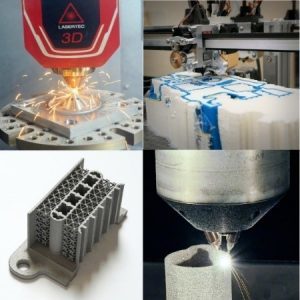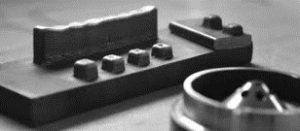By Dave Pierson, Senior Design Engineer for MAGNET
Like Polaris MEP, MAGNET is a center in the MEP National NetworkTM, whose mission it is to strengthen and empower small and medium-sized manufacturing companies in the United States.
“I’ve heard additive manufacturing is key to driving innovation in our industry, but how does it really deliver value?”
“We’ve looked at some additive manufacturing machines, but how can we justify the expense when we’re trying to eliminate our capital expenditures?”
“Is additive manufacturing worth the investment?”
 I field questions like these every time I host or attend additive manufacturing conferences for small and medium-sized manufacturers (SMMs) through the MEP National Network™. As the Senior Product Development Engineer at MAGNET, part of the Ohio Manufacturing Extension Partnership (MEP), my goal is to educate SMMs and other MEP Centers on how additive manufacturing can help small businesses compete against larger industrial players. (Click here for a 2-part guide authored by our California sister-MEP.)
I field questions like these every time I host or attend additive manufacturing conferences for small and medium-sized manufacturers (SMMs) through the MEP National Network™. As the Senior Product Development Engineer at MAGNET, part of the Ohio Manufacturing Extension Partnership (MEP), my goal is to educate SMMs and other MEP Centers on how additive manufacturing can help small businesses compete against larger industrial players. (Click here for a 2-part guide authored by our California sister-MEP.)
I do this, in part, because of Ohio MEP’s participation in a 2017 NIST MEP award to Pennsylvania MEP to partner with America Makes, the Manufacturing USA Institute focused on additive manufacturing. This Institute works with industry, academia, government, and non-government agencies to innovate and accelerate additive manufacturing and 3D printing to increase U.S. global manufacturing competitiveness, and through our partnership, Ohio MEP is assisting MEP Centers and SMMs with adopting additive manufacturing strategies, including guidance on ROI benefits and affordable options for equipment purchases.
What’s the Big Deal about Additive Manufacturing?
Additive manufacturing is the next step for those already familiar with three-dimensional (3D) CAD technology. In essence, 3D CAD is foundational to utilizing additive manufacturing. Once you’ve mastered the core competencies of 3D CAD, you’re ready to transition to additive manufacturing.
Ways Smaller Manufacturers Reap ROI from Additive Manufacturing
Originally developed by MIT, additive manufacturing adds layer upon layer of materials to “print” a 3D object or part. These parts can be created from a variety of materials, including plastics, metals, ceramics, or concrete.
Additive manufacturing can provide significant ROI to SMMs by helping them:
- Improve their industrial tooling processes
- Produce more high-value, low-run parts
- Create highly customized products for their industry and their customers
 This technology also empowers manufacturers to conduct more cost-effective prototyping for R&D processes. Additive manufacturing can quickly and efficiently distill user experiences into a mockup, so manufacturers can produce and evaluate a 3D-printed prototype. Repeated feedback cycles can yield more ideas for more value-added parts.
This technology also empowers manufacturers to conduct more cost-effective prototyping for R&D processes. Additive manufacturing can quickly and efficiently distill user experiences into a mockup, so manufacturers can produce and evaluate a 3D-printed prototype. Repeated feedback cycles can yield more ideas for more value-added parts.
Aerospace and medical manufacturers are already seeing the ROI benefits from additive manufacturing. Today, a growing number of smaller manufacturers are using it to transition to a more digital inventory, where you can support 40 parts that each have different SKUs vs. five thousand parts with the same SKU.
Say you’re a company who produces sand casting or specialty tools. I help companies like these learn how to use additive manufacturing to print those parts in a couple of weeks, instead of months. With less lead time needed to create parts, it’s easier to transition to a digital inventory.
Strategic-minded manufacturers are turning to additive manufacturing to compete with larger players in their industry. But the majority of SMMs still have a lot of questions on how this technology will really deliver value in both the short term and for the long haul.
Here are some of the most common additive manufacturing questions I’ve received from SMMs and other MEP Centers.
1. What Specific Applications Can Benefit from Additive Manufacturing?
Does your facility use injection molding? Additive manufacturing allows cooling channels to be designed and built to contour to the mold, thus improving cooling performance. This process extends the life of the mold and reduces waste.
This technology is also more efficient for lightweighting, with more material options available, such as lightweight plastics and composites. The process also uses less material, while improving part performance.
If you’re currently using metal castings, you can use additive manufacturing to print sand molds and cores from a CAD design without the need for a pattern or core box. Unlike typical industrial casting tools, additive manufacturing can significantly reduce the time and expense for producing molds and cores.
2. Can Additive Manufacturing Save Lead Time & Production Costs?
 Additive manufacturing provides the ability to print customized, just-in-time parts. It reduces tool development time and costs, with less material and less waste. Potential uses include holding, guiding, aligning, locating, and clamping, as well as simple “go/no-go” gauges to check the fit and quality of components.
Additive manufacturing provides the ability to print customized, just-in-time parts. It reduces tool development time and costs, with less material and less waste. Potential uses include holding, guiding, aligning, locating, and clamping, as well as simple “go/no-go” gauges to check the fit and quality of components.
The precise nature of additive manufacturing means it dramatically increases time savings for the production of fixture-making for first-article inspections. As a result, machine tools, jigs, fixtures, or gauges can then be produced more quickly and with fewer defects.
This technology also improves the ability to coordinate measurement machine (CMM) inspections. Orek has used additive manufacturing to make hundreds of inspection fixtures for its CMMs. On average, the company estimates it saves $200 and six-and-a-half days versus having the fixtures machined. By utilizing additive manufacturing, Oreck has removed fixture making and CMM programming from the critical path.
3. Can Additive Manufacturing Help Repair High-Value Parts More Cost-Effectively?
Do you have high-value metal parts that are costly to replace? Directed energy deposition (DED) is a specific additive manufacturing application that can repair turbine blades and other high-end parts and equipment by rapidly depositing material on existing parts to extend their life.
This technology can also be combined with existing CNC equipment. The DED machinery builds the part and then the CNC equipment mills the part down to the right size and smoothness.
Taking Advantage of Your Additive Manufacturing Resources
There are numerous hands-on opportunities for SMMs to learn more about additive manufacturing and how this technology can help smaller manufacturers compete in today’s 3D-driven industrial landscape.
I would suggest starting with learning events provided by the Additive Manufacturing Users Group (AMUG) and the RAPID + TCT Conference produced in partnership with SME. SME helps manufacturers innovate, grow, and prosper by promoting manufacturing technology, developing a skilled workforce, and connecting the manufacturing industry.
The National Institute of Standards and Technology (NIST) also offers multiple educational resources on its additive manufacturing database, such as workshops for metal and polymer-based applications.

Additionally, MAGNET is currently working with MIT to develop a curriculum for about 60 MEP Center personnel for online additive manufacturing training. After the training class, MEP Centers like Polaris MEP will be able to develop a successful interface between SMMs and their customers by taking better advantage of available additive manufacturing resources.
Together, we’re building a competency and capabilities relationship between the MEP National Network, SMMs, and their customers. The intended result is that SMMs will be able to use additive manufacturing to stay competitive not just in one year, but also in five and 10 years from now.
About the Author
MAGNET is part of the Hollings Manufacturing Extension Partnership (MEP) Program.
Dave Pierson is a Senior Design Engineer for MAGNET and a notable figure in the advanced manufacturing (AM) community. He has 25 years of varied and practical additive manufacturing training experience that covers seven AM standards categories as set by the American Society for Testing and Materials.
